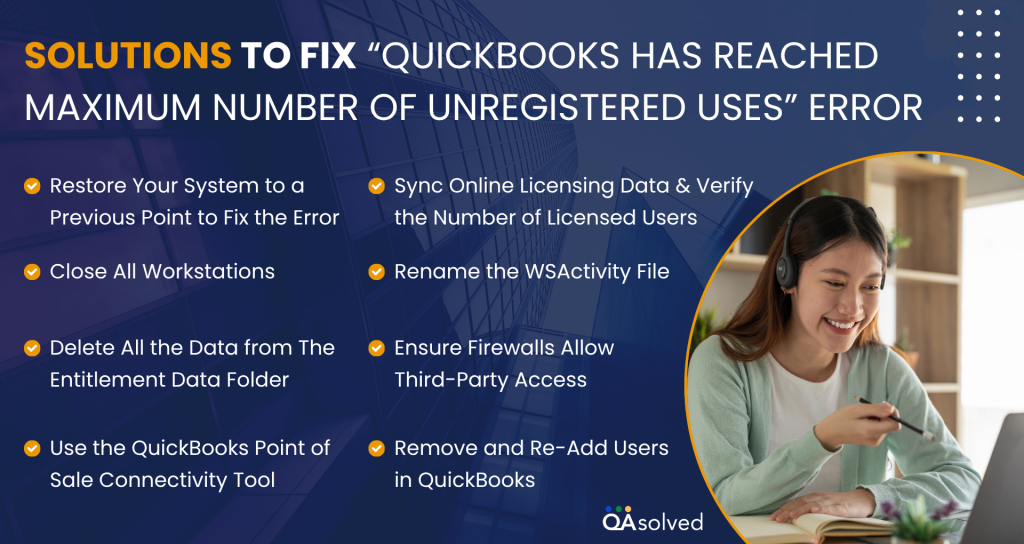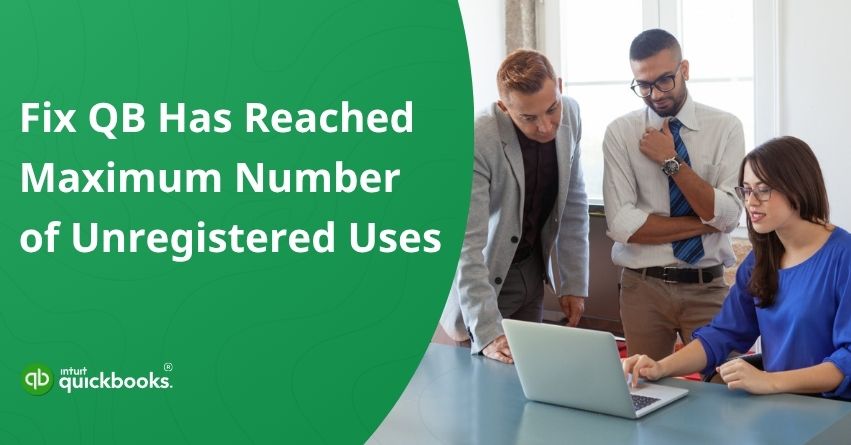Picture this: you open QuickBooks, ready to finish your weekly reports, manage payroll, or send out a few invoices. Everything seems to be running smoothly until suddenly, a pop-up message interrupts your flow saying, “QuickBooks has reached the maximum number of unregistered uses.” In an instant, your productive morning turns into a confusing tech hurdle that leaves you wondering what went wrong. If this has happened to you, don’t worry because you’re definitely not the only one. The QuickBooks unregistered uses error is quite common among users, and while it may seem complex at first glance, it can be resolved with a few easy and reliable fixes.
Most of the time, the QuickBooks unregistered uses error appears when the software encounters issues verifying your license, or when certain registration files become damaged or outdated. The good thing is that you do not need to be highly technical to overcome it. In this blog, we’ll guide you through each step carefully, explain the causes in simple terms, and share effective solutions to help you fix this problem. By the end, you’ll be able to access your company file and continue working in QuickBooks without a single hiccup slowing you down. So, let’s dive into this.
Pre-Fix Requirements to Ensure a Smooth Troubleshooting Process
Before attempting to fix the QuickBooks unregistered uses error, it’s crucial to take a few preparatory steps. Proper preparation ensures that you don’t lose important data and that the troubleshooting process goes smoothly without further complications. By checking your permissions, backing up data, and verifying system requirements, you can minimize risks and resolve the issue efficiently. Here are five essential pre-fix requirements:

1. Authorized Access to QuickBooks
Ensure that you are authorized to register, re-register, or de-register QuickBooks. Only users with proper licensing permissions should attempt these actions to avoid further registration issues.
2. Backup Your Accounting Data
Before making any changes, take a complete backup of your QuickBooks company files. This ensures your data remains safe in case anything goes wrong during troubleshooting.
3. Administrator Rights
Verify that you have “Administrator Rights” on your computer. Without admin access, QuickBooks may not allow changes to registration or system files necessary for resolving the error.
4. Stable Internet Connection
A reliable internet connection is necessary for QuickBooks to communicate with its servers during registration, updates, or verification processes, which help prevent interruptions during the fix.
5. Updated QuickBooks Version
Ensure that you are using the latest QuickBooks version. Updating the software can prevent compatibility issues and reduce the chances of encountering repeated registration errors.
By completing these pre-fix requirements, you set yourself up for a smoother and safer troubleshooting process. Moving forward, we will share the best solutions and step-by-step methods to fix the QuickBooks unregistered uses error, so you can quickly regain full access to your accounting software without any disruptions.
8 Solutions to Fix “QuickBooks Has Reached Maximum Number of Unregistered Uses” Error
Now that you’ve completed all the pre-fix requirements, it’s time to move on to the most effective methods for resolving the QuickBooks unregistered uses error. Below are some tried-and-tested solutions that can help you fix the “QuickBooks has reached maximum number of unregistered uses” error and prevent it from recurring in the future.

Solution 1: Restore Your System to a Previous Point to Fix the Error
Follow the steps to restore your system to a previous point to troubleshoot this error.
- Open your system and sign in to QuickBooks as an administrator.
- Click the Start Menu on your computer.
- Search for System Tools in the menu.
- Under System Tools, select System Restore.
- In the new window, choose the option Restore My Computer to an Earlier Time.
- Click Next to proceed to the list of restore points.
- Select On this list to view available restore points.
- Choose the most recent restore point you saved previously and click to select it.
- Press Next, and when prompted, allow your computer to restart to begin the restoration process.
- Once your system restarts, the restoration will be completed, returning your computer to the selected previous state.
- Open QuickBooks and check whether the maximum number of unregistered users error has been resolved.
Solution 2: Close All Workstations
Sometimes, the QuickBooks has reached maximum number of unregistered users error appears because multiple workstations are running the program simultaneously. Closing all active QuickBooks Point-of-Sale (POS) sessions helps refresh the system and release any occupied licenses. Follow these steps to close all running workstations:
- Open QuickBooks Point-of-Sale on each active workstation.
- Navigate to the File menu located on the top toolbar.
- Click on the Exit option to close the application properly.
- Do not close QuickBooks using the X button in the top-right corner. Doing so may prevent the system from freeing up licenses correctly.
- After closing QuickBooks on all workstations, restart each computer connected to the POS network.
- Once all systems have restarted, open QuickBooks again and check if the error has been resolved.
If the issue persists even after completing these steps, move on to the next troubleshooting solution.
Solution 3: Delete All the Data from The Entitlement Data Folder
Here are the steps to delete all data from the entitlement data folder and fix this issue once and for all.
- On the Point-of-Sale server, right-click the Windows Start button and select Open Windows Explorer from the menu.
- In the Explorer window, click on Organize and choose Folder and Search Options.
- Go to the View tab and select Show hidden files, folders, and drives. Then, uncheck the box next to Hide protected operating system files to make hidden folders visible.
- When a warning prompt appears, click Yes to confirm your action, and then select OK to save the settings.
- Navigate to the folder path: C:\ProgramData\Intuit\Entitlement Client\XX (Replace “XX” with the highest version number you find in the folder.)
- Press Ctrl + A to select all files in that folder, then press Delete and confirm by clicking Yes in the pop-up dialogue box.
- Once the files are deleted, restart QuickBooks Desktop Point-of-Sale and begin the registration process again. This should refresh your license data and resolve the error.
Solution 4: Use the QuickBooks Point of Sale Connectivity Tool
Another recommended way to resolve the QuickBooks has reached maximum number of unregistered users error is by using the QuickBooks Point-of-Sale connectivity tool. This helpful utility scans your system for any issues or conflicts within your network and security settings. It identifies inconsistencies that may be preventing QuickBooks from communicating properly and provides guided recommendations to fix those problems efficiently. Here are the steps:
- Download the QuickBooks Point-of-Sale Connectivity Tool from the official website.
- Launch the tool on the system where QuickBooks Point-of-Sale is installed.
- Follow the on-screen prompts to perform the network and security diagnostics.
- Once the scan is complete, review the results and make the recommended changes to your network and security settings to resolve the issue.
Solution 5: Sync Online Licensing Data and Verify the Number of Licensed Users
One of the most effective ways to resolve the QuickBooks unregistered uses error is by syncing your online license data and verifying the number of licensed users. This ensures that your software registration details are up to date and properly linked with Intuit’s server, helping eliminate any license mismatch issues. Follow these steps to verify your licensed users:
- Open QuickBooks and navigate to the Help menu.
- From there, select Manage My License.
- Then click Sync License Data Online and press OK to confirm.
- Now, go back to the Help menu again, choose Manage My License, and select Buy Additional User License to view the user’s license details.
- Finally, check the number of licensed users currently registered and verify that it matches your purchased licenses to ensure everything is synchronized correctly.
Solution 6: Rename the WSActivity File
- Navigate to the C:Program DataIntuitQuickBooks Point-of-Sale XXIni.
- Locate the file named WSActivity, right-click on it, and select Rename from the menu.
- Type OLDWSActivity as the new file name, then click anywhere on the screen to save the change.
- Once done, launch QuickBooks Desktop Point-of-Sale again and check if the error has been resolved. The software will automatically generate a new WSActivity file upon restart.
Solution 7: Make Sure that the Third-Party and Internet Security Firewalls are Set Up to Permit Access
- Open the Control Panel on your computer and navigate to System and Security > Windows Firewall to access your firewall settings.
- On the left panel, click Advanced Settings to open the advanced firewall configuration window.
- In the new window, select Inbound Rules from the sidebar, then click on New Rule from the options on the right.
- When prompted, choose Port as the rule type and click Next to continue.
- Enter the specific port numbers required by QuickBooks Point-of-Sale to establish a proper connection with its servers. Don’t forget to enter these details:
- TCP Port: 443
- UDP Port: 55333
- Allow the connection
- Name: QuickBooks Point-of-Sale
- Click on Finish to save the changes.
Solution 8: Remove and Re-Add Users in QuickBooks
To fix the “QuickBooks has reached the maximum number of unregistered users” error, one effective approach is to remove the existing users and then add them back again.
- Log in as Administrator.
- Remove the users. Follow the steps:
- Open QuickBooks and go to the Company menu.
- Select Users, then click on Set Up Users and Roles.
- From the list of existing users, choose the user you wish to remove.
- Click Delete User and confirm the action when prompted.
- After removing the necessary users, re-add them to ensure proper user setup and license allocation.
- Re-add the users. Follow the steps:
- Return to the Set Up Users and Roles section and click Add User.
- Enter the new user’s name and password as required.
- Assign the appropriate roles and permissions based on the user’s responsibilities.
- Click Save to finalize the process and ensure the user is properly added back into QuickBooks.
- After re-adding the user, make sure their account is fully registered. To verify, go to the Help menu, select Manage My License, and choose Sync License Data Online to update and confirm the registration.
What are the Steps to Reset the Registration of QuickBooks?
Resetting the QuickBooks registration can help resolve persistent QuickBooks unregistered uses errors by refreshing the license and product information. Follow these steps carefully:
- Step: Locate the qbregistration.dat file on your system.
- Step: For Windows 7, 8, and Vista users, navigate to: qbregistration.dat file you need to click on Program data followed by Common records and then finally hitting the Intuit QuickBooks.
- Step: Right-click the file and rename it, adding .old at the end (e.g., qbregistration.dat.old) to create a backup.
- Step: Open Notepad and paste the registration code (e.g., xx.x) into a blank document. Enter the License Number or Product Number associated with your QuickBooks application when prompted.
- Step: Save the Notepad file and give it a .dat extension to match the original file format.
- Step: Replace the original qbregistration.dat file with this newly created .dat file or select it in the directory as needed.
- Step: Complete the process by resetting QuickBooks registration using the new file and entering the registration code when prompted.
This procedure refreshes QuickBooks’ registration data and often resolves the maximum unregistered users error.
7 Factors that Trigger the “QuickBooks Has Reached Maximum Number of Unregistered Users” Error
Encountering the QuickBooks unregistered uses error can be stressful, especially when you’re trying to access important financial data. This error typically occurs when the software is unable to verify its registration due to system issues, corrupted files, or conflicts with other programs. Understanding the common triggers can help you resolve the problem more quickly and prevent it from recurring. Here are seven main reasons that often lead to this error:
1. Disturbance in the Windows Framework
If the Windows framework experiences technical glitches or functional disruptions, QuickBooks may fail to verify registration details, triggering the unregistered users error during startup or when accessing company files.
2. Malware or Virus Attack
Malicious software or viruses can damage QuickBooks related files or essential Windows processes, interfering with license validation and causing the QuickBooks unregistered uses error to appear unexpectedly.
3. Sudden or Improper System Shutdown
Abruptly shutting down your computer or QuickBooks while the program is running can corrupt important configuration or registry files, preventing proper license verification.
4. Software Conflicts from Other Applications
Running multiple programs simultaneously can consume system resources and interfere with QuickBooks processes, causing it to hang or display the maximum unregistered users error during operation.
5. Faulty or Incomplete Installation
An improper or incomplete installation of QuickBooks or its supporting components may prevent the software from recognizing registration files correctly, resulting in repeated error messages.
6. Outdated QuickBooks Version
Using an older version of QuickBooks can lead to compatibility issues with Windows updates or server validations, which may trigger the unregistered users error and affect smooth operation. This is why it has become extremely significant for users to keep their QuickBooks updated to the latest release.
7. Damaged License or Registration Files
If the QuickBooks license or registration files are corrupted, missing, or accidentally deleted, the program may fail to authenticate activation, causing persistent unregistered user errors and access restrictions.
Conclusion
Dealing with QuickBooks has reached maximum number of unregistered users error can be frustrating, especially when it disrupts your daily accounting tasks. However, with the right approach, this issue is completely fixable. From syncing your license data online, closing active workstations, and clearing entitlement files to renaming WSActivity, configuring firewall settings, using the POS Connectivity Tool, removing and re-adding users, performing a system restore, or resetting the registration file, each solution targets a specific cause of the error.
By following these steps carefully, you can restore proper functionality to QuickBooks and ensure smooth, uninterrupted access to your accounting software. Implementing these fixes not only resolves the immediate problem but also helps prevent similar issues in the future, keeping your business operations running efficiently.
Frequently Asked Questions
To add additional licensed users in QuickBooks Desktop, go to the Help menu on your dashboard, select Manage My License, and then click Buy Additional Users. Enter the required details, and you will gain access for the extra users to use QuickBooks seamlessly.
QuickBooks Enterprise supports up to 40 active users working simultaneously. If certain users appear unregistered, it typically means that their license information has not been properly synced with the system, or they have not yet been added as fully licensed users. Ensuring that all user data is correctly registered and synced will resolve this issue and allow all users to access QuickBooks without restrictions.
Yes, you can install QuickBooks on several computers using a single license; however, only one user can access the software at a time. To allow multiple users to work simultaneously on different computers, you must purchase additional user licenses.
QuickBooks allows up to 30 users to work on a company file simultaneously, depending on the version. QuickBooks Pro supports a maximum of three concurrent users, while QuickBooks Premier allows up to five. The server itself is not counted as a user if it is not actively accessing QuickBooks. For QuickBooks Enterprise Solutions, significantly more users can work on the company file at the same time, making it suitable for larger teams.
To delete a user from QuickBooks, follow these steps:
Step 1: Go to the Settings tab.
Step 2: Click on Manage Users.
Step 3: Locate the user you want to remove and click the arrow icon next to their name.
Step 4: Select Delete.
Step 5: Confirm the action by clicking Delete again in the confirmation window.
The selected user will then be successfully removed from your QuickBooks database.


